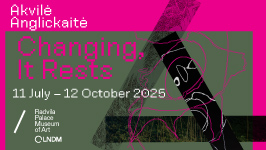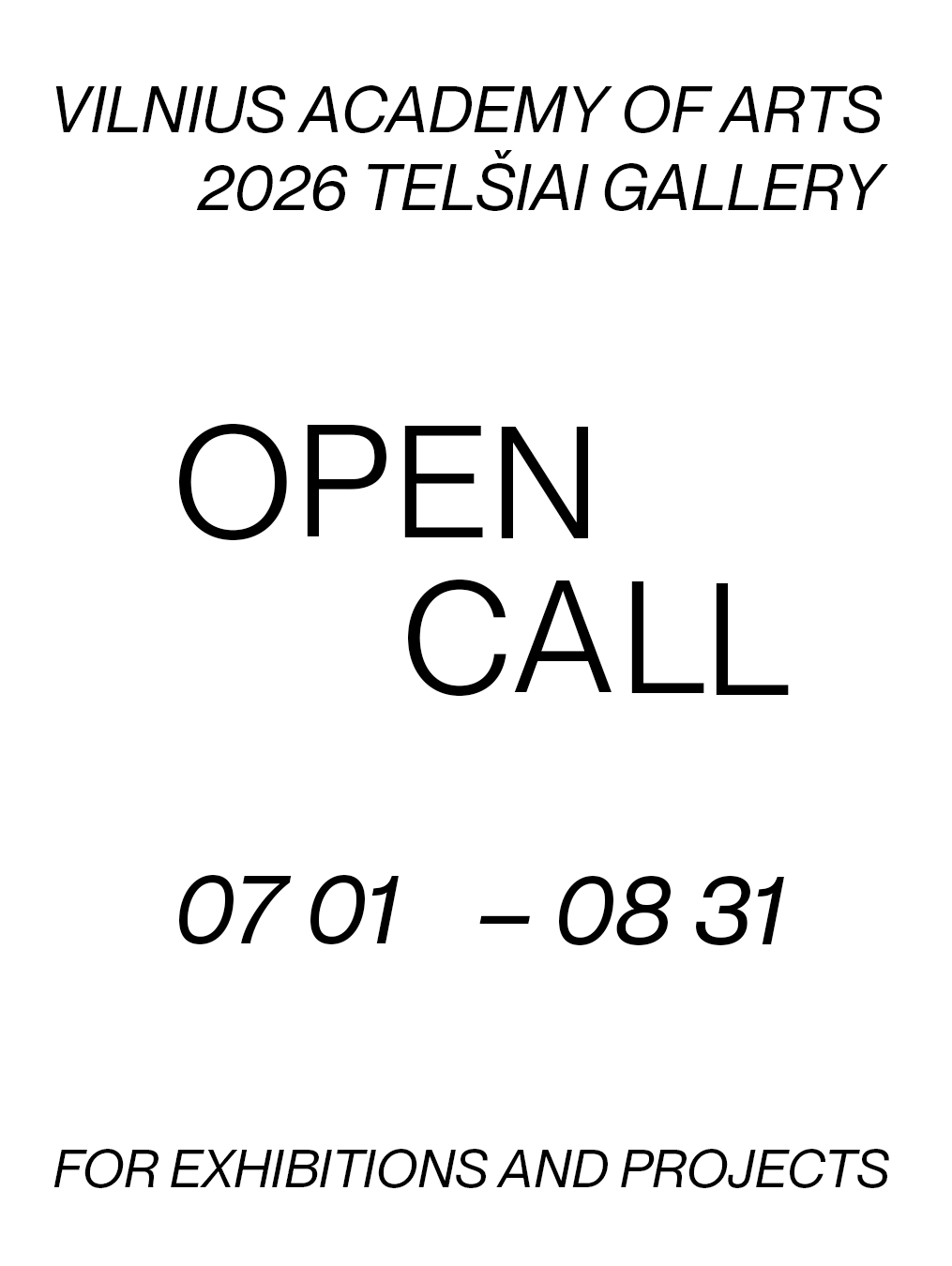Paulius Andriuškevičius: It’s great to have a conversation with you, Gražina, after a long hiatus. Tell me, how long have you been working for the Peggy Guggenheim Collection, and what is your current role there?
Gražina Subelytė: I came to the Peggy Guggenheim Collection as an intern in September 2007, and I’m currently an associate curator. So it’s about 15 years since I first arrived here and didn’t speak a word of Italian. To cut a long story short, after my internship I was asked to stay and manage the internship programme, and ultimately a new job was created for me (which didn’t exist at the museum before), to be curatorial assistant to the museum director, and eventually I became a curator.
PA: I interned in 2013 and still remember fondly that internship programme … I wonder if there have been new additions to the collections or any other significant changes in the past ten years? Could you also tell us about the role, goals, and current trajectory of the institution?
GS: So glad that you enjoyed the internship programme! It is quite special, and many professionals in the art world started here. The interns are truly an essential part of the team.
When it comes to the trajectory of the institution, I believe our director Karole Vail is better placed to answer this question. From my position as a curator, I can say that we are an institution dedicated to 20th-century art, because Peggy Guggenheim collected works from that period. In Venice, surrounded by contemporary art institutions such as the Biennale, we have a specific identity, and the public knows what kind of art to expect when they visit the museum. Peggy Guggenheim and her extraordinary legacy are at the heart of all our undertakings. In terms of exhibitions, we present a programme on artists that she supported, whose works she collected and/or exhibited, or which belonged to the same artistic circles or the same period. The shows always have an original angle to them, concentrating on an artist or an aspect of their work that might be less well known. For instance, I’ve just curated a large-scale exhibition ‘Surrealism and Magic: Enchanted Modernity’ inspired by works by artists such as Victor Brauner, Leonora Carrington, Max Ernst and Leonor Fini in our holdings (Peggy Guggenheim was one of the world’s most important collectors of Surrealist art). The exhibition aimed to show that interest in magic and the occult was paramount in Surrealism, and not marginal as was previously thought. Currently, among other projects, I’m working on an exhibition about Guggenheim Jeune, Peggy Guggenheim’s gallery in London (1938-1939), to show how truly ground-breaking that space was, and that there is still so much to know about the collector beyond the narrative we might be familiar with.
In terms of the permanent collection, here, too, it is fundamental for us to reveal the less well-known but crucial aspects of her collecting. For instance, we’ve exhibited works such as the sculpture Drifting No. 2 (1959) by the Japanese artist Tomonori Toyofuku, the painting Heavenly Bodies (1946) by the Mexican artist Rufino Tamayo, the fantastic large-scale painting Ireland (1958) by Grace Hartigan, and Op and Kinetic works that Peggy Guggenheim collected, as well as her collection of art from Africa, Oceania and the Americas. We periodically rehang the permanent collection, and always find new aspects to highlight.

“Surrealism and Magic: Enchanted Modernity”, April 9– September 26, 2022. Peggy Guggenheim Collection. Photo: Matteo De Fina

“Surrealism and Magic: Enchanted Modernity”, April 9– September 26, 2022. Peggy Guggenheim Collection. Photo: Matteo De Fina

© “Surrealism and Magic: Enchanted Modernity”, April 9– September 26, 2022. Peggy Guggenheim Collection. Photo: Matteo De Fina
In all we do it’s key for us to show how the art that Peggy Guggenheim collected continues to be incredibly relevant in this day and age, as there are parallels with today’s world. Now, as throughout history, humanity is undergoing a time of transformation, prompted by societal and political developments, technological advancements, wars, climate change, the pandemic, and other related factors that directly or indirectly influence our state of being. This influence makes itself deeply felt in art too, with works of art becoming the documents that reflect such revolutionary shifts. The 20th century was a time of profound political, social and artistic changes. What today we, seemingly paradoxically, call ‘classical modernism’ went forward by experimenting and revolutionising the idea of what art can be, and finding radical and fresh ways to represent inner and outer reality. The artists we represent at the Peggy Guggenheim Collection broke with tradition and contested artistic legacies. They invented new modes of making art that reflected the changing values and conventions. We always stress these aspects, showing that the art patron Peggy Guggenheim and her collection embody a truly revolutionary character, from which we can learn a lot. It is the perfect springboard to discuss the radical shifts represented by movements such as Cubism, Futurism, Surrealism, Abstract Expressionism, Art Informel, and so much more. Ultimately, these artists’ perspectives can inform and inspire us to transform our reality both on a societal and an individual level.
Last, but not least, we’ve been very active in the conservation area, led by our conservator Luciano Pensabene. Masterpieces such as Jackson Pollock’s Alchemy (1947) have been researched in-depth and restored. The curatorial and conservation departments collaborate extensively in this area, and studies such as this can help us better understand the artists’ working methods and reveal new aspects of their practice. For example, in the case of Pollock, it was often assumed that he created his drip paintings in one go, but the study helped us establish that he did not apply all layers of paint at once, and even worked on several works simultaneously over time.

© Peggy Guggenheim Collection. Photo: Matteo De Fina

© Peggy Guggenheim Collection. Photo: Matteo De Fina
PA: It’s quite symbolic that it is Pollock’s Alchemy, undoubtedly one of the icons of the collection, that gets restored and once again is the centre of attention. It is often said that it is largely due to Peggy (with Duchamp by her side), her interest in his art, and her omnipresent influence, that Pollock became an art sensation. From being a janitor to the first great American artist in less than a year, it sounds like one of those classic art anecdotes that art history is full of. And yet it somehow feels relevant today as artists’ careers are forged overnight at biennales, art fairs and studio visits, and you still hear these from-rags-to-riches stories. Venice is one of the main traffic points for contemporary art, and a place where various types of art transaction take place. What are your thoughts on today’s art world and its dynamics? What do you make of the role of the art collector at the current time in art history? And what values and benefits, or perhaps detriments, do you associate with collecting contemporary art?
GS: Regarding Pollock, I love the words of the brilliant painter (and Pollock’s wife) Lee Krasner: ‘What one should say about Peggy [Guggenheim] is, simply, that she did it.’ Besides Marcel Duchamp, she had a few other advisors. Yet she had wonderful intuition as a collector and patron, also marked by great acumen and a progressive spirit. I know that Guggenheim remains a key inspiration for many collectors today. She didn’t see art as an investment, but rather saw it as her duty to support the contemporary art of her time, helping to launch the careers of artists like Pollock. She took chances and recognised the artist’s talent long before many others did. While of course today’s world is different from what it was when she was alive, there are plenty of wonderful collectors. Here in Italy, I think of Patrizia Sandretto Re Rebaudengo, who avidly supports new generations of artists. Certainly, the world is much better connected today, and there is so much on offer on a global level. But in that offer, there is so much great art too. And in some cases (like in Pollock’s), the talent of the artist can be apparent immediately.

© Peggy Guggenheim Collection. Photo: Matteo De Fina

Peggy Guggenheim with her Lhasa Apsos terriers on the Grand Canal terrace of Palazzo Venier dei Leoni, Venice, 1960s. Photo Archivio Cameraphoto Epoche. Solomon R. Guggenheim Foundation, Venice, Gift, Cassa di Risparmio di Venezia, 2005.
PA: Tell me more about your curatorial practice. How do you select, approach and perform research on the subjects and themes of your projects? In addition, do you curate the work of contemporary artists at all, and if so, in what ways is it different from working with the oeuvre of deceased artists, and do you prefer one to another for any reason?
GS: I specialise in 20th-century art and did my PhD at the Courtauld Institute of Art in London in the area of Surrealism. So I study movements and artists of the 20th century in-depth, and also the exhibitions that Peggy Guggenheim organised during her lifetime, either in her first gallery, Guggenheim Jeune (1938-1939), in London or her museum-gallery The Art of This Century in New York (1942-1947). I’m always impressed with how much there is yet to be discovered about her support for artists! For instance, she organised ground-breaking exhibitions, both group exhibitions and many solo shows, dedicated to women artists, such as Janet Sobel, Irene Rice Pereira, Sonja Sekula and Virginia Admiral, to name just a few.
Most of the artists represented in our collection have unfortunately passed away, and in those cases, I read as much as possible and always learn about the latest scholarship and exhibitions, and look for new angles to approach their art. I spend lots of time conducting in-depth research on the objects and their presentation (for instance, how the artist would have preferred to show their work). And yet it is not just about the objects, but also various sets of relations, whether that of the artist to other fellow artists, history, various other disciplines, etc. So you’re constantly in-between micro and macro perspectives. I curate both collection-based shows and loan-based exhibitions. Some of these can be thematic, others are chronological, or a mix of both. Some are group shows, others are monographic exhibitions. For me, exhibitions are a form of storytelling, and as a curator, you weave a narrative together, comparable to reading a book. However, while exhibitions should teach us and provide us with certain answers, they should also challenge us and make us ask questions.
As for contemporary art, there are already so many other institutions in Venice that show it, and we’ll leave that to them! But of course, I’m deeply interested in contemporary art and meet many fantastic artists. It is particularly interesting to see the continuity of certain ideas through the ages too.

René Magritte, Black Magic (La magie noire), 1945, oil on canvas, 79 × 59 cm. Musées Royaux des Beaux-Arts de Belgique, Bruxelles. Bequest of Mrs. Georgette Magritte, Brussels, 1987 © René Magritte, by SIAE 2022. Photo: J. Geleyns
PA: Your mention of a Guggenheim Jeune exhibition made me revisit Peggy’s autobiography Out of This Century and her memories of that period of her life. Even though, judging from her equally vibrant and straightforward way of writing, it seems to me that back then she put her love affairs before her art, it is also evident that it was a pivotal moment in her becoming an art collector, because that is when she started actively acquiring artists’ work. Can you elaborate on the themes, the selection of artists, and some of the stories you are planning to tell in your upcoming show? Are there any interesting facts and/or narratives regarding the topic that have surfaced since you embarked on the project? What drives you most regarding this particular exhibition, and when do you expect it to open?
Indeed, in many ways, the London period was the catalyst for Peggy Guggenheim’s role as the great collector that she became, and therefore instrumental in forming her identity as a patron of the arts. She was a key mover and shaker in London in the late 1930s, and contributed to the visibility and acceptance of what at the time was the most contemporary art in the capital. During quite a short period, she organised over 20 exhibitions and many curatorial firsts, including Jean Cocteau, Vasily Kandinsky, Wolfgang Paalen, Grace Pailthorpe and Reuben Mednikoff, possibly the first collage show in the UK, and the contemporary sculpture show that caused a scandal. She gave shows to artists such as John Tunnard, Charles Howard, Jill Salaman and Rita Kernn-Larsen … The last exhibition in Europe of Stanley William Hayter’s celebrated print studio Atelier 17 also took place at Guggenheim Jeune. So the exhibition I’m curating together with Simon Grant will highlight just how ground-breaking this gallery was, and that there is so much more to Peggy Guggenheim’s story.

Jeu de Marseille, 1941. Musée Cantini, Marseille, Gift of Aube Breton Elléouët and Oona Elléouët in memory of Varian Fry, 2003. Victor Brauner, Hélène Smith, Siren of Knowledge—Locks, March 1941, black and colored pencil on tracing paper, 27.4 × 18.1 cm © Victor Brauner, by SIAE 2022
PA: What is your relationship with the art and artists of your home country? I would imagine you visit the Lithuanian Pavillion in the Biennale, but do you get to see shows when you are visiting Lithuania? What are your impressions?
GS: Every time I come back to Vilnius, I try to see as much as possible, including the National Gallery of Art, MO Museum, the CAC … And it’s not just the temporary exhibitions. At the National Gallery of Art, for instance, I’m always interested in seeing the display of the permanent collection and to see the works of Lithuanian artists from the modern period (which we represent at the Peggy Guggenheim Collection). I wish I could come back more often, but things are very busy in Venice! And naturally, I always visit the Lithuanian Pavilion, and generally think Lithuania has an incredibly strong contemporary art scene.
PA: Venice is a timeless city that envelops one in this strange and unique environment, very much defined by art, but other things too. I certainly have a soft spot for the floating city, as I imagine many of our readers do. Taking into account the fact that you have outlived many biennales, acqua altas, vaporetto rides and cicchetti, can you tell us a little about your favourite places to visit in Venice, for food, drinks, art and sightseeing?
GS: I love Osteria La Zucca: it is simple, but serves delicious fresh food, fantastic vegetable dishes. Osteria alle Testiere is also a very special place. Dinner at Nevodi restaurant also never disappoints. Enoteca Schiavi, not too far from the Accademia bridge, is great for an informal evening out with friends, and offers a wide selection of cicchetti and wines. In terms of art and sightseeing, there is so much on offer that it is hard to choose, but I like popping into the Gallerie dell’Accademia, located very close to the Peggy Guggenheim Collection, to admire their numerous masterpieces. Otherwise, what I enjoy most are long walks all around Venice … Just taking it all in and reminding myself what a miracle this city is.

Leonora Carrington, The Pleasures of Dagobert, 1945, egg Tempera on Masonite, 74.9 x 86.7 cm. Private Collection © Leonora Carrington, by SIAE 2022
PA: I would like to finish our conversation by moving our focus back to the art collected by Peggy. I know there are so many masterpieces at Palazzo Venier dei Leoni, and choosing favourites might be difficult, but can you select one piece that you are particularly attracted to and present it briefly?
GS: The first painting I fell in love with here was Giorgio de Chirico’s The Red Tower (1913). It seems so simple, and yet there’s a mysterious invisible dimension to it. Between 1911 and 1917, de Chirico painted typical Italian piazzas, bizarrely empty of humans, but populated with odd combinations of objects. While at first glance The Red Tower seems to be a straightforward realistic depiction, the scene’s incongruities and peculiarities rapidly become apparent. Silence, melancholy and a lack of incident prevail, and yet the scene conveys a feeling that something disquieting has just happened, or perhaps is about to occur. The mood is both unnerving and strangely nostalgic. The quality of light, too, is contradictory: the shadows are implausibly long, the perspective is skewed, and the tower appears to loom too close in the foreground. The equestrian statue ought to be at the centre of the piazza, but it is shunted off to the right. While the title indicates that the scene’s key subject is the red tower, in fact it is the air of obscured and unsettling reality that dominates the work … For de Chirico, every object embodied two appearances: what is visible to the human eye, and the invisible realm beyond (thus ‘metaphysical’). The work always reminds me of the importance of seeing beyond appearances.





























